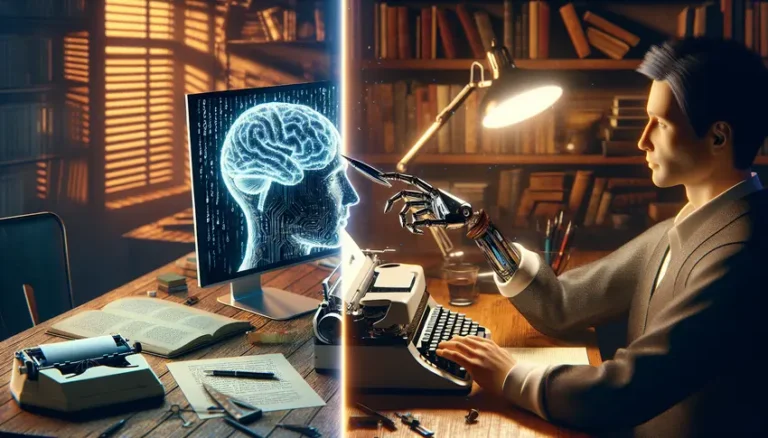AI in Education: Revolutionizing Learning and Teaching
Artificial Intelligence (AI) is rapidly changing how we live, work, and learn. In education, AI offers exciting possibilities to personalize learning, automate tasks, and make education more accessible. This guide explores how AI in education is transforming classrooms and institutions, creating a brighter future for students and educators alike.
Are you ready to discover how AI in education can revolutionize learning and teaching? This guide will walk you through the current applications, benefits, ethical considerations, and future trends of AI in the educational landscape. Let’s explore how AI is shaping the future of education!
Understanding the Impact of AI in Education
AI is no longer a futuristic concept. It’s a present-day reality in education. From personalized learning experiences to streamlined administrative tasks, AI is making a significant impact. Let’s break down what AI really means in the context of education.
Note: AI, in simple terms, is the ability of computers to perform tasks that typically require human intelligence. This includes learning, problem-solving, and decision-making.
What is Artificial Intelligence (AI)?
Artificial intelligence (AI) refers to the simulation of human intelligence processes by computer systems. These processes include learning (the acquisition of information and rules for using the information), reasoning (using rules to reach approximate or definite conclusions), and self-correction. AI exists in many forms. Some are:
- Machine Learning (ML): Algorithms that allow computers to learn from data without explicit programming.
- Natural Language Processing (NLP): Enables computers to understand and process human language.
- Computer Vision: Allows computers to “see” and interpret images.
These AI technologies are being used in education to create more effective and efficient learning environments. You can also explore how to fine-tune DeepSeek for specific educational applications.
The Current State of AI in Education
AI is already being used in various aspects of education. These include:
- Personalized Learning Platforms: AI analyzes student data to tailor lessons and provide customized feedback.
- Automated Grading Systems: AI tools can grade assignments and exams, freeing up teachers’ time.
- Intelligent Tutoring Systems: AI tutors provide students with personalized support and guidance.
- Accessibility Tools: AI-powered tools help students with disabilities access educational materials.
These applications are just the beginning. As AI technology advances, we can expect even more innovative uses in the future.
How AI is Revolutionizing Learning
One of the most promising aspects of AI in education is its ability to personalize the learning experience. Every student learns differently. AI can adapt to individual needs, strengths, and weaknesses.
Personalized Learning Paths
Imagine a classroom where every student has a learning path tailored just for them. AI makes this possible. AI-powered platforms analyze student performance and adjust the difficulty and content of lessons accordingly.
For example, if a student is struggling with a particular concept, the AI system might provide additional exercises or explanations. If a student is excelling, the system might offer more challenging material. This ensures that students are always learning at their optimal level.
Example: Khan Academy uses AI to track student progress and provide personalized recommendations. Duolingo adapts language lessons based on a learner’s performance.
AI-Powered Tutoring Systems
AI tutors can provide students with personalized support and guidance, much like a human tutor. These systems can answer questions, provide feedback, and offer hints to help students solve problems.
What sets AI tutors apart is their ability to provide instant feedback and support, 24/7. This can be especially helpful for students who need extra help outside of the classroom.
Example: Socratic by Google uses natural language processing to help students understand concepts and solve problems step-by-step.
Adaptive Assessments
Traditional assessments often provide a one-size-fits-all approach. Adaptive assessments, powered by AI, adjust the difficulty of questions based on a student’s performance. If a student answers a question correctly, the next question will be more challenging. If a student answers incorrectly, the next question will be easier.
This approach provides a more accurate assessment of a student’s knowledge and skills. It also helps to keep students engaged and motivated, as they are always being challenged at the right level.
Reminder: Adaptive assessments provide a more personalized and effective way to measure student learning.
Transforming Teaching with AI
AI in education isn’t just about improving the student experience. It’s also about empowering teachers. AI can automate many time-consuming tasks, freeing up teachers to focus on what they do best: teaching and mentoring.
Automating Administrative Tasks
Teachers spend a significant amount of time on administrative tasks, such as grading, attendance tracking, and scheduling. AI can automate many of these tasks, saving teachers valuable time.
For example, AI-powered grading systems can automatically grade multiple-choice tests and provide feedback on student essays. AI can also assist with scheduling parent-teacher conferences and tracking student attendance.
Example: Grammarly and Turnitin use AI to automate grading, plagiarism detection, and feedback provision.
Providing Data-Driven Insights
AI can analyze student data to provide teachers with valuable insights into student performance. This data can help teachers identify students who are struggling, track student progress, and adjust their teaching strategies accordingly.
For example, AI can identify patterns in student performance that might not be apparent to the naked eye. This can help teachers to intervene early and provide targeted support to students who need it most.
Note: AI can help teachers make data-informed decisions to improve student outcomes.
Creating Engaging Learning Materials
AI can help teachers create more engaging and interactive learning materials. For example, AI can generate quizzes, create presentations, and even design virtual field trips.
This can help to make learning more fun and engaging for students. It can also help to cater to different learning styles, as AI can create materials in a variety of formats.
Example: AI tools can generate modules and descriptions for classes based on the subject, grade level, and learning objectives.
Enhancing Accessibility and Inclusivity with AI
AI in education has the potential to make education more accessible and inclusive for all students, regardless of their background or abilities. AI-powered tools can help to break down barriers to learning and create a more equitable educational environment.
Assistive Technologies for Students with Disabilities
AI can provide assistive technologies for students with disabilities, such as text-to-speech and speech-to-text applications. These tools can help students with visual impairments, dyslexia, and other learning disabilities to access educational materials and participate fully in the classroom. Consider exploring AI in virtual reality for immersive learning experiences for students with disabilities.
Example: Microsoft Immersive Reader helps students with visual impairments or dyslexia by reading text aloud or translating materials into other formats.
Breaking Down Language Barriers
AI-powered translation tools can help to break down language barriers, making education more accessible to non-native speakers. These tools can translate text and speech in real-time, allowing students from different linguistic backgrounds to participate fully in learning activities.
Example: Google Translate can provide real-time translation of text and speech, allowing students to communicate with teachers and classmates in their preferred language.
Personalized Support for Diverse Learners
AI can help to provide personalized support for diverse learners, such as students with learning disabilities or students from disadvantaged backgrounds. AI can analyze student data to identify individual needs and provide targeted support to help students succeed.
Reminder: AI can help to create a more equitable and inclusive educational environment for all students.
Ethical Considerations of AI in Education
While AI in education offers many benefits, it’s important to consider the ethical implications. We need to address potential risks to ensure AI is used responsibly and ethically. You may want to review AI safety development for more information.
Data Privacy and Security
AI systems rely on collecting and analyzing large amounts of student data. It’s crucial to protect this data and ensure student privacy. Schools and institutions must adopt robust policies and technologies to safeguard student data from unauthorized access and misuse. It’s also important to understand DeepSeek’s approach to data privacy in educational settings.
Note: Protecting student data is paramount when implementing AI systems.






